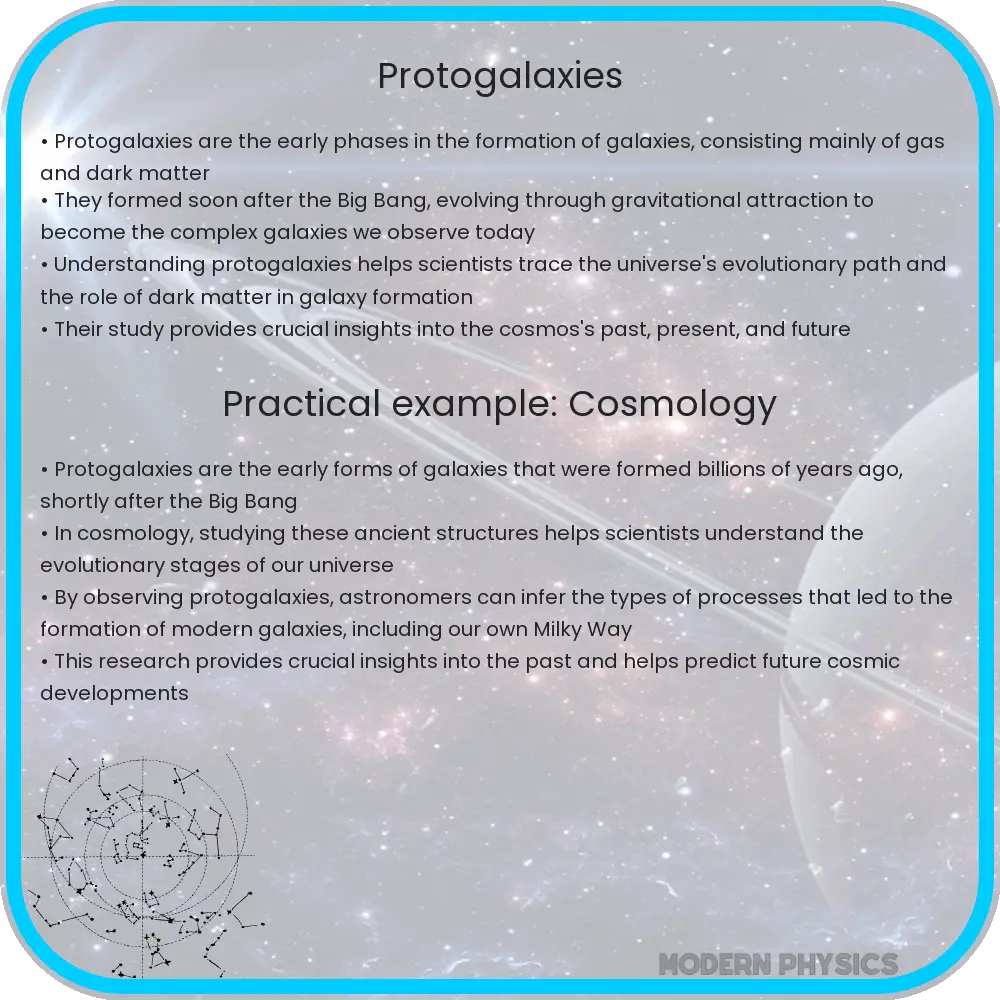Explore the formation, evolution, and observation of protogalaxies, the early structures shaping the cosmos, and the challenges and prospects in their study.

Understanding Protogalaxies: The Dawn of Galactic Structures
Protogalaxies, the precursors to the fully formed galaxies we observe today, represent the earliest stages in the life cycle of galactic formation. Emerging from the gravitational collapse of density fluctuations in the early universe, these initial structures mark a significant epoch in cosmic evolution. This article delves into the formation, evolution, and observation of protogalaxies, shedding light on our universe’s nascent years.
Formation of Protogalaxies
The formation of protogalaxies is intricately linked to the Big Bang and subsequent cosmic inflation. Following this monumental event, the universe was filled with a nearly uniform, hot plasma of protons, electrons, and photons. As the universe expanded and cooled, regions of slightly higher density began to attract surrounding material through gravity, forming the first dark matter halos. These halos served as the scaffolds for protogalaxies, pulling in gas and dust to form the first stars and stellar clusters.
Evolution into Modern Galaxies
The evolution from protogalactic clouds to the complex galaxies we see today involved several processes over billions of years. Initially, these early structures were small and lacked the distinct features of modern galaxies. Through processes such as cooling and fragmentation of gas, star formation, and subsequent supernova explosions, they gradually accumulated mass and complexity. Mergers between protogalaxies played a crucial role, leading to the diverse range of galaxy shapes and sizes found in the current universe.
Observing Protogalaxies
Observing protogalaxies presents substantial challenges due to their great distances and faint luminosities. However, advancements in telescope technology, such as the James Webb Space Telescope (JWST), have enabled astronomers to peer further back in time and space. By analyzing light that has traveled for billions of years, researchers can study the conditions and characteristics of these early structures. Spectroscopy, in particular, provides valuable information on the chemical composition, temperature, and motion of gas within protogalaxies.
Through these observations, scientists can reconstruct the physical conditions of the early universe, offering insights into the fundamental processes that shaped the cosmos. The study of protogalaxies not only enriches our understanding of galactic formation and evolution but also illuminates the underlying principles governing the universe’s large-scale structure.
Challenges in Protogalactic Research
Despite technological advancements, studying protogalaxies remains fraught with challenges. One major obstacle is their immense distances from Earth, which results in extremely faint signals by the time they reach us. Additionally, distinguishing between small, distant protogalaxies and nearby faint objects requires highly sensitive and accurate instruments. Another challenge lies in the interpretation of data due to the complex processes involved in early galaxy formation, such as the effects of dark matter and varying star formation rates.
Future Prospects in Protogalactic Exploration
The future of protogalactic exploration is bright, with several initiatives poised to enhance our understanding significantly. Upcoming space telescopes and ground-based observatories are expected to provide deeper, higher resolution images of the early universe. These advancements will enable the detection of even fainter objects, potentially uncovering new details about the epoch of reionization and the initial mass distribution of protogalaxies. Moreover, improvements in computer simulations will aid in interpreting observational data, offering more accurate models of protogalactic formation and evolution.
Conclusion
Protogalaxies stand as the historical archives of the universe, offering a glimpse into the cosmic dawn where the first structures began to take shape. Through the formation, evolution, and observation of these primordial entities, astronomers unravel the mysteries of the early universe, bringing clarity to the processes that led to the rich tapestry of galaxies observed today. While challenges remain in studying these distant objects, ongoing advancements in technology and methodology continue to push the boundaries of our understanding. As we peer deeper into the cosmos, the study of protogalaxies remains a pivotal chapter in the ongoing quest to comprehend the universe’s grand narrative.
